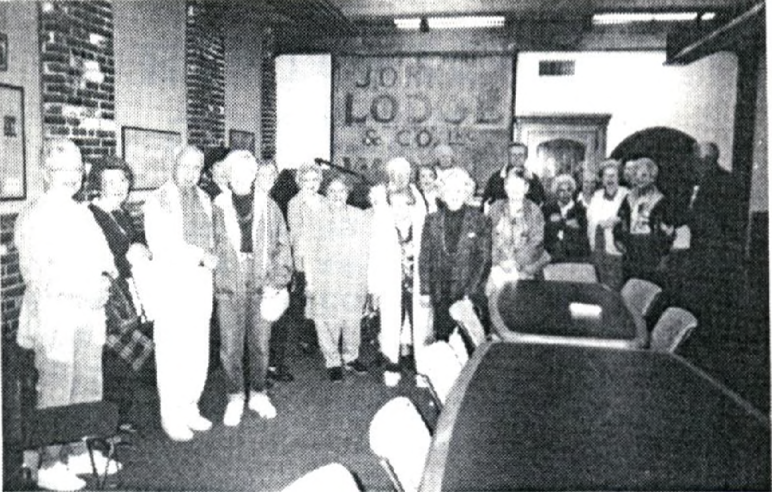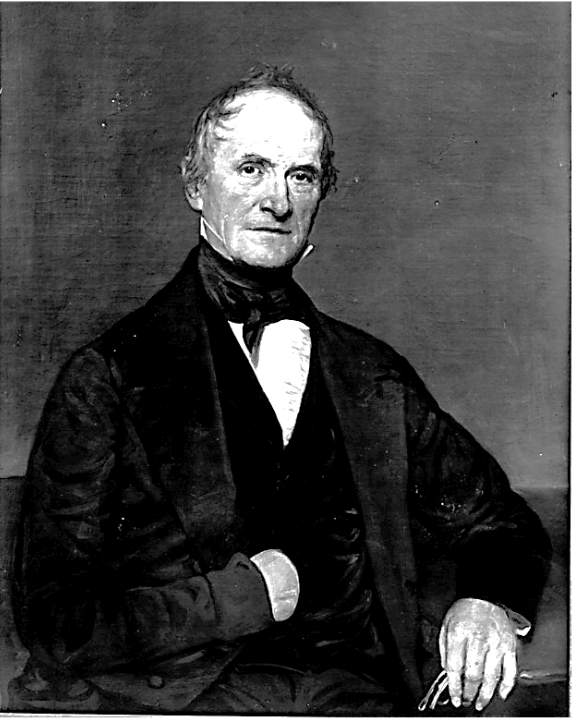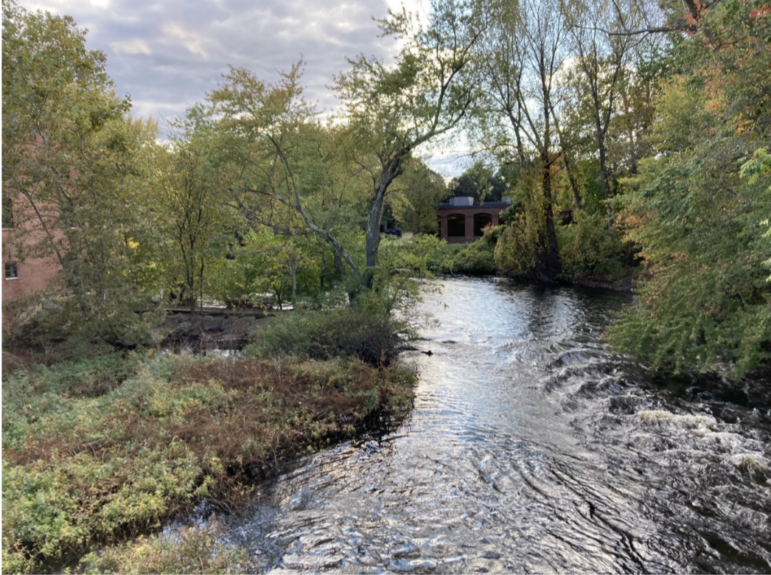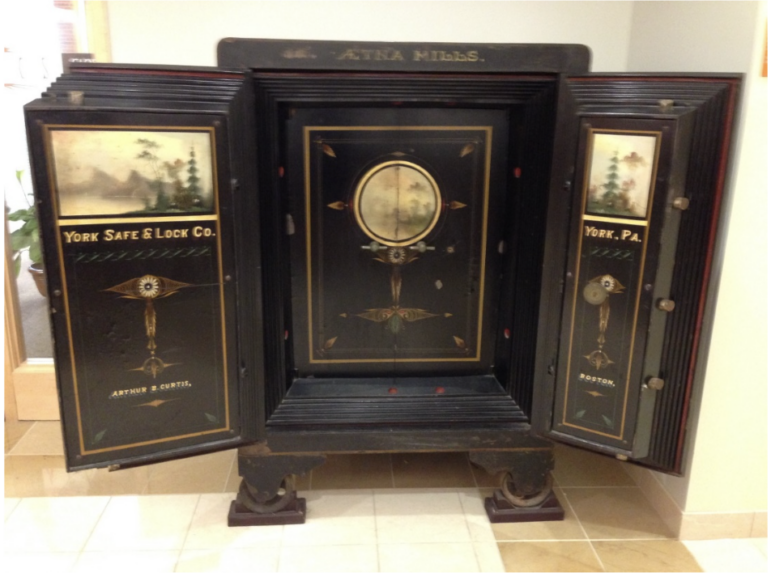
The following story is part of a series on local history provided by the Historical Society of Watertown. It was written by Paul Brennan, former President and former Vice President of the Historical Society for the October 1998 Historical Society newsletter, “The Town Crier.” When Paul was President, he lived in the Fowle House for 5 years and in December 2000 was named the “Town Historian” by the Town Council.
AETNA MILLS
On September 27, 1995, Paul Brennan, President of the Historical Society, greeted the members of the Senior Center for the sixth time in about a year for yet another much anticipated historic tour of a long-forgotten treasure of our town, the Aetna Mills. After a question and answer period in the Senior Center, the group of thirty members boarded the shuttle and traveled down to the banks of the Charles River to view one of Watertown’s early industrial influences of the 18th and 19th century.

The large complex of red brick buildings located at the corner of Bridge and Pleasant Streets is now owned and occupied by The Boston Scientific Corporation (Editor’s 2023 Note: Boston Scientific is no longer in this location). These buildings rise up along the banks of both sides of the Charles River. The common thread between Newton and Watertown at this point of the river was here, where the parent company of the old Aetna Mills was conceived. The Bemis Mills Company was the parent company to The Aetna Mills Company. The original history of this mill is very interesting.
The dam on which the mill is located was built by David Bemis and Enos Sumner in 1778. David Bemis owned 64 acres of land on the Watertown side of the Charles River and Enos Sumner owned land on the Newton side. In 1779, Enos Sumner sold his land on the Newton side to three men who built a paper mill. David Bemis became two-thirds owner of this the next year. His sons, Luke and Isaac, became sole owners and carried on the business of paper making until the death of Isaac in 1794.
In 1778, David Bemis built a grist-mill and snuff-mill on the Watertown side of the Charles River, the first mill on this side. His sons, Seth and Luke, became full owners upon the death of David in 1790.
In 1796, Seth bought out his brother Luke and began to manufacture chocolate and to prepare dye-woods and medicinal woods and roots for use. In 1803 he began the spinning of cotton by machinery, making cotton warp. This procedure produced far superior cotton to that spun by hand, and Mr. Bemis could not keep up with the demand. The business became quite profitable.
In 1812, with the aid of an Englishman, Seth Bemis initiated the use of the first illuminating gas in America made from coal, and used it to light his factory. This practice was discontinued after a few years, however, because of the gas leaking from the tin tubes through which it was conducted.
By 1839, the business was owned by Seth Bemis and Seth Bemis Jr. Bemis Mills was manufacturing cotton and woolen goods on both sides of the river. The Newton side was also manufacturing drugs and dye woods.

In 1847, the dye wood business was sold to William F. Freeman, and in 1860, the entire
property. William F. Freeman & Company transferred the property to the Aetna Mill Company, who greatly expanded the works on the Watertown side of the Charles River. Between these mills was a rolling dam, claimed by some to be the only one in America. Another also exists in England at Warwick Castle.

While water wheels supplied part of the power required by the mills, steam was also desirable. For heating, drying and other purposes, a steam engine was required. Four large boilers were used requiring about three tons of coal each day.
There were many different departments in the mill: The sorting department contained, at times, over 100,000 pounds of wool of various kinds; Australian wools, cashmere, camels’ hair, etc. The scouring-room and the dyeing-room stored numerous kinds of dyes required to produce a great variety of shades of all colors.
The dyed wool was then passed through the dryers, the picker-room and the gauze-room to the carding- room. Here the wool was cleaned and untangled before spinning. Next it was spooled, that is, the wool was spun and wound on bobbins to get it ready for weaving. The huge spinning jennies that did this were capable of doing the work of several hundred people with far greater accuracy and evenness of thread. In the weaving department, the product was transferred to looms of different degrees of complexity, depending on the desired finished product. The most important step of all in the manufacture of cloth is in the finishing department. The product was now inspected, pressed, measured, folded and packed for shipment to market.
The improvement of the manufacture of woolen goods resulted in Aetna Mills’ products being touted as among the finest and best woolen goods found in the market. In 1931, Aetna Mills moved to Lowell, Massachusetts. The mill buildings were auctioned off and bought by John T. Lodge Company in 1934, who continued to manufacture woolen goods here.

In 1982, Boston Scientific Corporation moved into the buildings on the Charles River. This company is a worldwide developer, manufacturer and marketer of medical devices. They sell products in numerous product categories which are used by physicians to perform less invasive medical procedures. These products are used in a wide range of interventional medical specialties, including cardiology, gastroenterology, pulmonary medicine, radiology, urology and vascular surgery.
Very interesting history; I remember many, many years ago as my brother crossed over Bridge Street, observing a idle, decaying water paddle wheel attached to the side of a building; it had to be sometime in the mid 1940’s.
I am curious to know where “Rowell, Massachusetts” might have been. Articles in the Boston Globe and Fitchburg Sentinel at the time say that Aetna Mills had a branch in Fitchburg called “Shirreff’s Worsted Company” and that the Aetna company headquarters in Watertown had been closed “to concentrate the business” there in Fitchburg.
I found the original article from 1995. It looks like it said “Lowell”.
Thanks
3/3/’24-The dyes probably floated into the waters of the Charles so I’m not sure what praise any of them should receive.